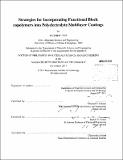| dc.contributor.advisor | Michael F. Rubner and Robert E. Cohen. | en_US |
| dc.contributor.author | Tan, Wui Siew | en_US |
| dc.contributor.other | Massachusetts Institute of Technology. Dept. of Materials Science and Engineering. | en_US |
| dc.date.accessioned | 2012-03-16T16:03:45Z | |
| dc.date.available | 2012-03-16T16:03:45Z | |
| dc.date.copyright | 2011 | en_US |
| dc.date.issued | 2011 | en_US |
| dc.identifier.uri | http://hdl.handle.net/1721.1/69794 | |
| dc.description | Thesis (Ph. D.)--Massachusetts Institute of Technology, Dept. of Materials Science and Engineering, 2011. | en_US |
| dc.description | Cataloged from PDF version of thesis. | en_US |
| dc.description | Includes bibliographical references. | en_US |
| dc.description.abstract | This thesis explores the creation of thin film responsive hydrogel coatings via Layer-by Layer assembly (LbL) of temperature (T) responsive block copolymer - polyelectrolyte multilayers (PEMs). First, the LbL conditions that allow for temperature driven, large, reversible swelling transitions of multilayer constructs are determined. Use of weak polyelectrolyte components and selection of an appropriate deposition pH were found to be the critical factors that allowed large scale reversible swelling. These factors were the missing pieces that explain the lack of temperature response reported in prior literature. A series of block copolymer (BCP) molecules were subsequently synthesized to expose the influence of BCP architecture on the temperature responses of these micelle-PEMs. Diblock architectures that lack connectivity in the Tresponsive poly(propylene oxide) block disintegrate quickly at low temperature. Triblock copolymers on the other hand allow access to a wide range of reversible swelling behavior. The dynamic interplay of various pH, salt concentration and T effects on the swelling and stability of these hydrogels are also further explored. In particular a critical ratio of charged block to Tresponsive block length is necessary for film stability at low temperature. As a whole these systems can be customized to either swell reversibly (by up to 6 times their dry thickness) or disintegrate under specific sets of pH, time, temperature, and salt conditions, making them useful for a wide range of smart applications. The application of these conformal temperature responsive coatings to T-gating of membranes; creation of nanotube structures; T-enabled loading and release of proteins; as well as their tunable disintegration, useful for triggered release, is discussed and demonstrated. On a separate note, the utility of inorganic nanoparticle LbL assembly in creating conformal thin UV anti-reflection coatings for PMMA Fresnel lenses is demonstrated. Key features of thin porous nanoparticle coating assembly via LbL is discussed, including how particle size and deposition pH can tune the coating porosity and refractive index. In addition, we develop several strategies for stabilization of these inherently weak systems largely composed of air. In particular, a novel means to generate stable inversely structured surface nanoporosity in thermoplastic materials is developed. | en_US |
| dc.description.statementofresponsibility | by Wui Siew Tan. | en_US |
| dc.format.extent | 231 p. | en_US |
| dc.language.iso | eng | en_US |
| dc.publisher | Massachusetts Institute of Technology | en_US |
| dc.rights | M.I.T. theses are protected by
copyright. They may be viewed from this source for any purpose, but
reproduction or distribution in any format is prohibited without written
permission. See provided URL for inquiries about permission. | en_US |
| dc.rights.uri | http://dspace.mit.edu/handle/1721.1/7582 | en_US |
| dc.subject | Materials Science and Engineering. | en_US |
| dc.title | Strategies for incorporating functional block copolymers into polyelectrolyte multilayer coatings | en_US |
| dc.type | Thesis | en_US |
| dc.description.degree | Ph.D. | en_US |
| dc.contributor.department | Massachusetts Institute of Technology. Department of Materials Science and Engineering | |
| dc.identifier.oclc | 777368376 | en_US |
